Establishing family routines that suit a life on the go is not a one size fits all process. Every family has their own set of circumstances and personalities to contend with. If, however, you do travel a lot as a family or your family is constantly on the go, I recommend being intentional about how you structure your days.
Wouldn’t the most travel-friendly approach be to NOT have structure?
It might seem that the best way to leave room for spontaneity and adventure would be to have no schedule or structure – just a go with the flow mentality all around. I, however, have learned the hard way that it is important for my family that we have structure, enforce ground rules, and carry out discipline when we are on the go.
It was my unintentional default to let the rules relax a bit while on vacation and let poor behavior slide when traveling or out and about. Nobody likes having to discipline their child with an audience. So I often looked past things, thinking I would be more firm once we got home.
The lack of structure and discipline started to make traveling feel difficult.
But, after a very full season of travel a while back, I realized that this approach was starting to lead to increasing behavioral issues. We are away from home a lot. If my kids were always on holiday from the usual rules and expectations (be it how they behave, what they eat, or how much they sleep) it would not be healthy for anyone.
We found ourselves saying we needed to be on the road less so that we could get our kids’ behavior in check. Basically, the lack of structure and discipline started to make traveling feel difficult.
If we truly wanted to raise happy, healthy, and capable children AND show them the world, we needed to establish structure and utilize disciplinary techniques that we could take on the road with us. So there are no “holidays” from structure and discipline in our family. We have been very intentional about this for quite a while now and it works much better for us. Our kids thrive on the consistency and knowing what to expect no matter where we are.
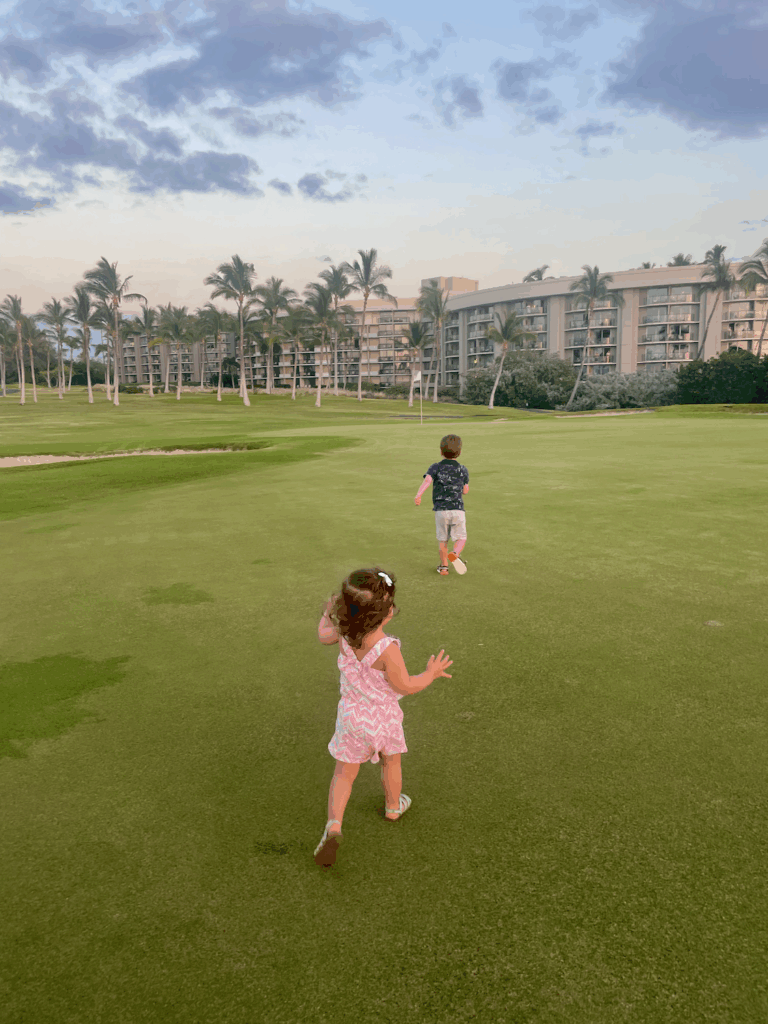
Fortunately, the more we stick to structure and enforce expectations, the less we have to discipline overall and the more we enjoy our time with our kids. This makes traveling with them a joy and something we continue to want to do.
And the biggest surprise: you can still travel the world, be out and about all day, and say yes to spontaneity while having structure to your life. You just need to be intentional about the structure you establish.
Schedules vs Rhythms vs Time Blocking
You likely know families in all of these camps. For some parents, schedules give them the structure that they need to confidently navigate their days. For others, a more loosey-goosey approach feels more natural.
Schedules
Families that follow schedules assign each task/activity a specific time or order. Breakfast is at 7:00am, at 8:00 am the kids have independent play time, at 9:30 it is snack time, etc. Little kids seem to really like schedules.
One of my children responds particularly well to schedules. Schedules can provide certainty and something for families to hold onto in an otherwise chaotic day. It is no surprise that classrooms tend to utilize clearly communicated schedules to manage a large number of little humans. My schedule-minded child loves morning circle time at school when they go over the day’s schedule.
Rhythms
For other people, however, schedules are too rigid. And that is when rhythms can add some needed structure without crushing their desire for flexibility and spontaneity. Rhythms are basically how your day flows and feels.
Consider the tempo of your day. How does the tempo change throughout the day? For us, it starts fast right out of the gates in the morning (really, as soon as our first child wakes up). We continue at that pace all morning, but just when we are all starting to feel drained, the pace slows way down mid-day. Then it picks back up in the late afternoon before slowing to a stop at the end of the day.
Time Blocking
Time blocking is an in-between approach that follows a schedule, but also plays off of rhythms. This form of structure involves breaking your day into chunks of time that you allocate specific tasks to. Time blocks can add just a pinch of a schedule to an otherwise rhythm-lead day.
There is plenty of content available online that will walk you through time blocking and how to arrange your family’s days in time blocks.
Rhythms and Time Blocks are easier to stick to on the road.
I find that rhythms and time blocks are the easiest to stick to on the go. Delayed flights, flat tires, and any other unforeseen bumps in the road can quickly derail a thoughtfully planned schedule. Rhythms and time blocks on the other hand can shift as your day progresses.
Plus, if your kids are having a fantastic time at the zoo, or really engaging with the exhibits at a museum, rhythms and time blocks give you the freedom to continue the fun and just shift things back a bit. Maybe your family’s two hour afternoon rest time block starts around 2:00 pm today, instead of 1:00pm. Or if you and your kids are having a rough day and rest time needs to be earlier, that is ok too!
The great thing about rhythms is that as long as you move through your usual rhythms each day, your young kids may not even realize nap time was moved up or back an hour. And you and your family still get those rest times that you all need, regardless of what exact time they happen. This gives you structure that does not constrain you.
Straying off a detailed schedule, on the other hand, can leave you as the parent feeling like things aren’t going right. And I don’t know about you, but when I feel like my day is not going right, the rest of the day will not go right. I try to keep the energy positive and just flow through our rhythms and routines no matter where we are and as it feels right on that particular day. And that keeps me feeling confident.
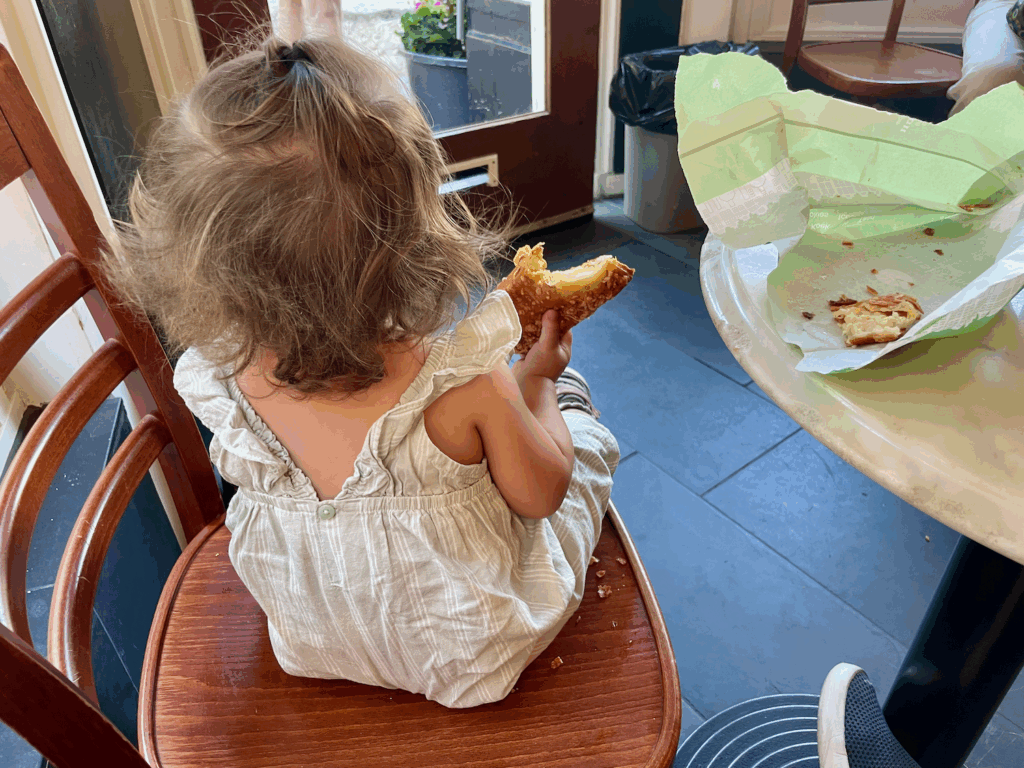
Rhythms and time blocks also tend to leave me feeling less overscheduled. When I look at a day as 12 hours to be filled and scheduled down to the minute, or even the hour, I tend to overfill my calendar. And I am really good at overfilling my calendar. On paper, it might seem doable to go to the pediatrician at 9:00 am and meet a friend at the zoo at 10:00 am. Or maybe the flight lands at 4:00 pm and dinner with a friend is at 6:00 pm. Appointments, usually only last about 20 min, and the restaurant is only 30 minutes from the airport. But there are long waits in the waiting room, delayed flights, and traffic to contend with, and let’s not forget how long it can take to load kids in and out of a car (and how it takes even longer if they are tired from a day of traveling).
I of course still have to schedule things for specific times, but the rhythms and time blocking helps me be realistic about what I can actually fit in to any particular window of time. I try to not schedule more than one thing in a particular time block, and I think about how those time blocks might shift as we move throughout a day. Even though our kids are often awake from nap by 3:30, it can take them a little while to come out of their groggy, post-nap state. If we go to the zoo in the morning, we probably will end up going down for naps later than usual, which means our rest time block will likely go a little later. MEANING, I should not commit to being somewhere at 4:15 pm on that day if I can avoid it.
What our days look like in our home and on the go:
If you take school out of the equation, our days don’t look much different whether we are at home or on the go. We are not schedule oriented, but rather follow certain rhythms. We also implement some very loose time-blocking.
This is what our kids’ days look like, pretty much every day, no matter where we are:
Breakfast time block (roughly 6am – 8am)
This time block is all about getting our day started and eating breakfast. Our kids don’t wake up at the same time. Some days there are a solid 1-1.5 hours between when the first and last child wakes up.
The kids may roll out of bed and head straight downstairs. Or, if it’s a cozy weekend morning they might climb in bed with one of us and read books while the other parent preps breakfast. Maybe the kids are going through a morning basket of independent activities until breakfast is ready. If it is a school day we get busy preparing preparing for school and packing school bags.
But making sure everyone has had a filling, nutritious breakfast is the primary task in this time block, whether we are at home, away, or at school. If a kid is up, ready for the day, and done with breakfast, they roll into an independent activity until the rest of us catch up.

High Energy time block (roughly 8 am – 1:00 pm)
The time block after breakfast is when my kids have the most energy. I know this is not the best time to plan a long car ride, a flight, or any other event/experience that requires them to be calm, cool, and collected. No long, relaxing Sunday brunches in this house.
At home we do a lot of outdoor play during this time.
When traveling, this is a good time to be moving and exploring a destination, preferably on foot. I also always prioritize a visit to a park when I can (especially if we are in Europe where the parks are out of this world amazing!) or another kid-friendly space where they can burn off a lot of energy.
My kids front-load their calories in a serious way. So we always have a mid-morning snack. Sometimes two. One child eats pretty much all morning whenever going through a growth spurt. I always have an abundance of nutritious snacks available for my kids. At home we like to make charcuterie boards. Each child can take what they want and I don’t feel like I’m constantly plating little meals for my ravenous kids.
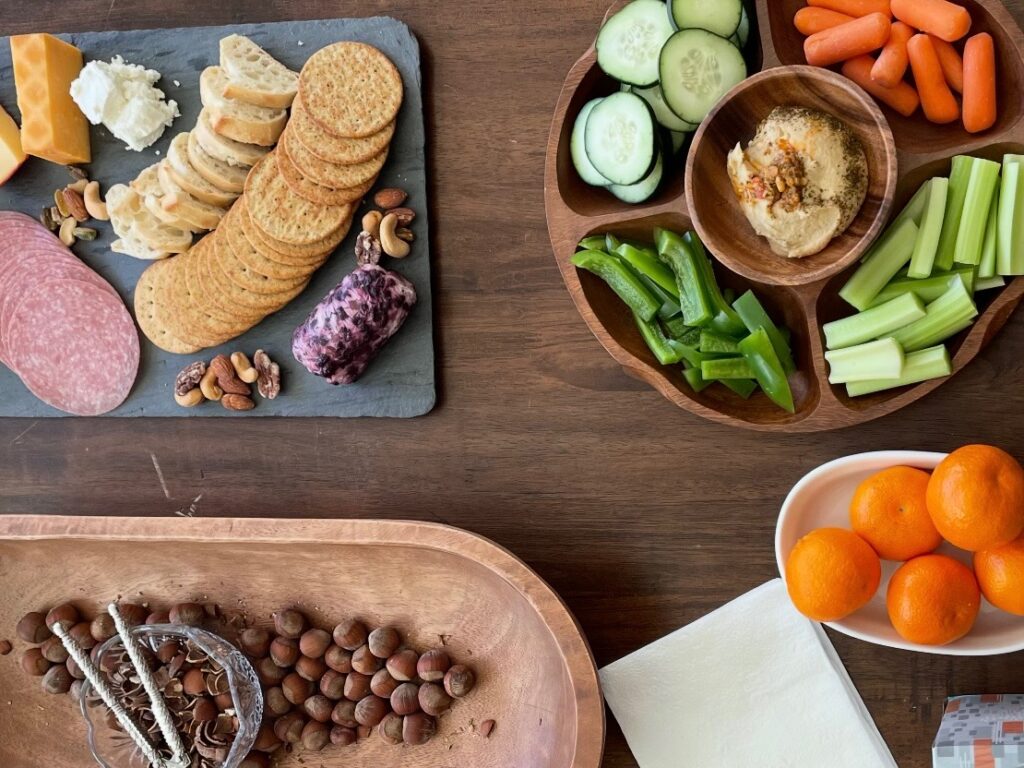
We end this block with a hearty lunch (often leftovers from the previous night’s dinner), which they usually eat anywhere between 11 and 1, depending on when they are hungry.
When we are traveling, we often opt to have lunch be the big meal that we eat out. We fill those little tummies and then they dose off to sleep. Then dinner can be more low-key at our accommodations or a quick bite out somewhere and not interfere with bedtime. Since dinner at restaurants tends to be more expensive than lunch, that can also save us some money.
Rest time block (roughly 1:00 pm – 4:00 pm)
This is the quiet block in our day. We give our nappers the opportunity to nap every day, and the older ones have a daily quiet time, no matter where we are.
If we are home or at other accommodations, nappers spend the time in bed and non-nappers quietly flip through books, draw, or listen to audio stories.
Car time counts as quiet time for those not napping. We use audio books, coloring supplies, and calming music to give them time to unwind on their own.
If it is a travel day, we try our best to time a drive, train ride, and even plain ride during this time block. Flying during this time can sometimes backfire if the flight is delayed and suddenly we are pushing our kids into an overtired state and end up boarding with cranky kids. But this timing has worked in our favor more times than not, so we continue to look for flight times that overlap with nap time.
If we are exploring a new place, this is the time of day that my husband and I will plan to visit museums, churches and other sites where you would not want a child running around. Nappers get carted around in the stroller and any non-nappers have usually burned off enough steam that some quiet time cruising around on the kickboard attachment to our stroller is a welcomed break.
Often the non-nappers are up well before this time block ends, but continue some quiet, independent play or have some one-on-one time with mom or dad.
Dinner time block (roughly 4:00 pm – 6:30 pm)
This time block revolves around family dinnertime. If eating at home, we try to involve the kids in some of the prep. If eating out somewhere, we try to sit down and make it a family experience. We often aren’t all present, whether due to work, activities, or other obligations. But those of us who are present, sit down together and eat at a table, without screens, and we chat.
Bedtime time block (roughly 6:30 pm – 8:00 pm)
Sometime in the first half of this block, we head to the kids’ beds. If they are taking baths or showers that day, they most often happen during this time block. But sometimes bathing happens in the first time block when they wake up or in the morning time block after a swim or an extra messy activity.
Then the kids pick out books for us to read. The number of books varies based on how late it is, but we let the kids know on their way to their beds how many they can pick out. Otherwise, our kids would read late into the night. Throughout the day, we try to vocalize limits as much as possible in order to manage expectations.
We usually don’t take many books with us when we travel. Sometimes we will buy a book that is relevant to our location so that we have something to read while away and can take home a memory. But otherwise, we come up with stories. Often we just retell little snippets of our own childhoods and our kids LOVE that.
Then they each have their quirky little routines that they have selected on their own to do with mom and/or dad. So after story time we carry out those little rituals (whether it’s singing a song, a game of tick-tack-toe, or saying their favorite thing about that day, etc.). Then, it’s lights out and us parents let out a big sigh and unwind ourselves.
Basically, no day looks the same. But they all follow the same rhythm, and our daily routines can happen no matter where we are.
Tips for Creating Family Routines
Your family routines and rhythms don’t need to, and probably shouldn’t, look like your friend’s. Come up with structure that works for your family!
Consider your circumstances when deciding what family routines you want to establish.
It’s easy to say we will have family dinners every night, but what if you or your spouse is not reliably home from work by that the time your kids are hungry? You might need to adjust that expectation.
Maybe that means a bigger afternoon snack for the kids and a lighter late dinner. Or maybe you decide that those who are home will sit down together and the others will join as they are available. It could be that dinner is not a big thing in your house, but Saturday breakfast is. Maybe meal-centric routines are not your thing, but ending evenings with a family bike ride or walk is!
Think about your own priorities when planning your family routines.
You can’t do everything, so establish routines that are practical for the life you want to live. For example, our kids don’t bathe every night. Bedtime already takes long enough without a nightly bath. We prefer to fill that evening time with activities like reading together on the couch, family walks after dinner, being outside, and burning off that last bit of energy. I have plenty of friends who chose to make a nightly bath part of their kids’ nighlty routine, and that works great for them. We chose to do something different.
Try to avoid having your routines tied to certain objects or locations.
If you make a favorite stuffed animal part of your child’s sleep routine, then you will have to take that stuffed animal everywhere you go and make sure you don’t lose it! It is super sweet when kids get attached to a favoirte lovie, so I’m not anti-stuffed animal attachment. The practicality of this attachment is just something to consider. If your child seems to seek attachment with items, maybe encourage something more portable than a big teddy bear.
We let our kids use pacifiers longer than we thought we would before we were parents. We have found that the pacifiers help with pressure changes on the planes and give our little ones something familiar at rest and bedtime. Outside of that, we don’t travel with specific lovies, stuffed animals or blankets to help our kids sleep. Any age-appropriate safe sleeping service will work, be it a stroller, a pack-and-play, a bed, or a sleeping bag.
Family Routines Examples that are travel friendly
- Singing songs
- Telling stories
- Saying prayers
- Discussing your favorite part of the day. No matter how terrible you thought your day was, identifying and talking about your favorite part of day (even if it is something tiny) can help you see beauty in your day.
- Going over the activities planed for the day
- Reading a book out loud to the kids while they eat breakfast.
The options are endless, just be intentional about what routines you establish.
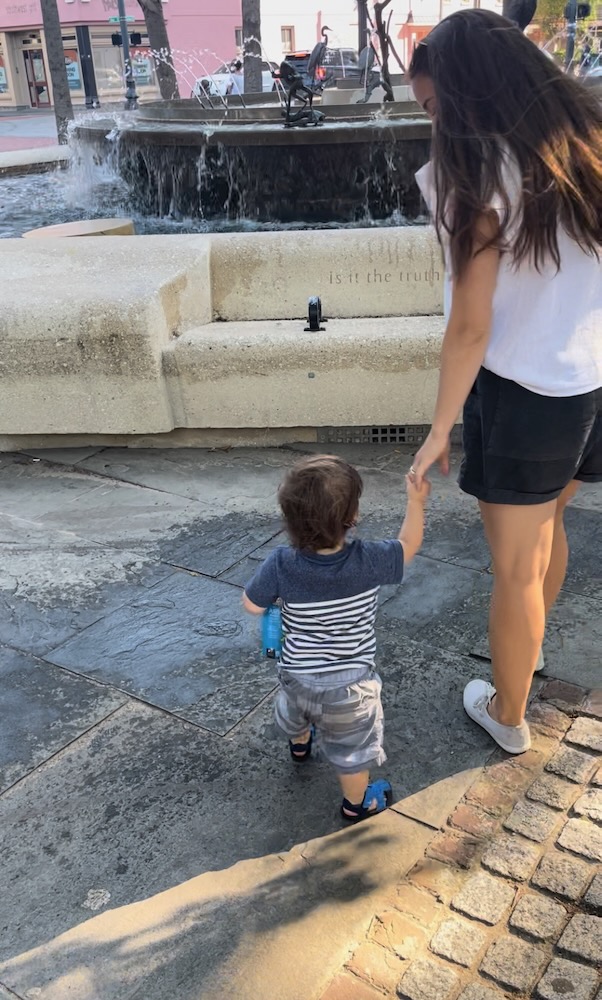
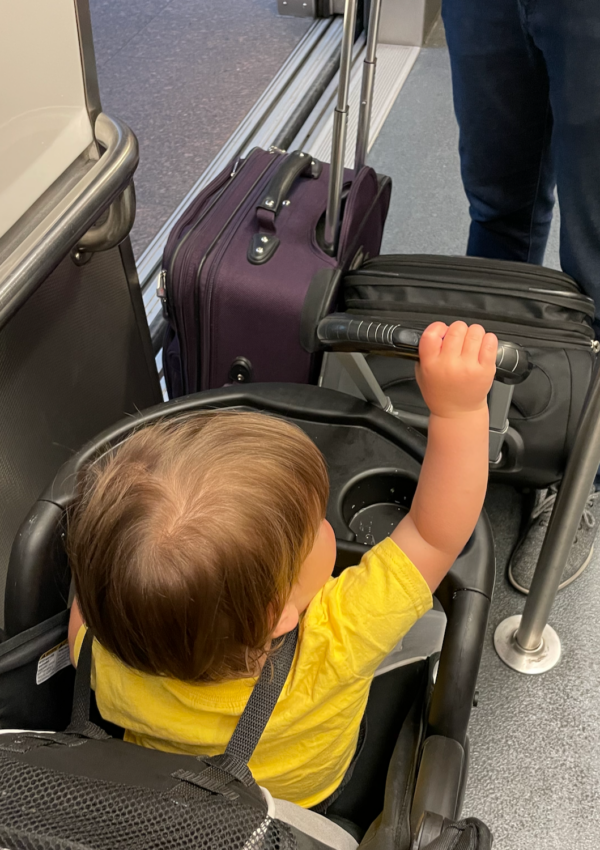



Leave a Reply